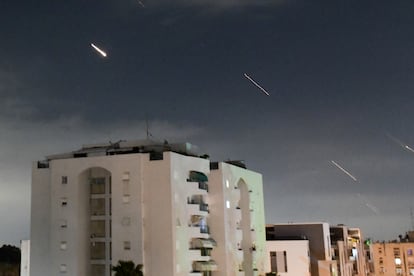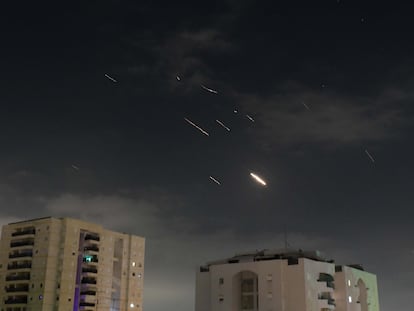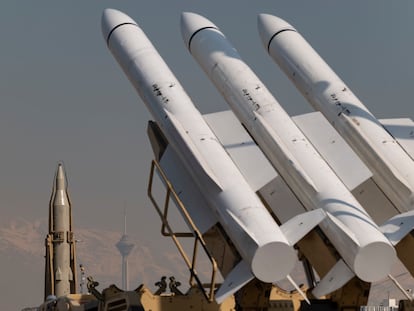How Israel intercepted Iran’s drones and missiles
Anti-aircraft batteries and jets from the U.S., the U.K. and Jordan shot down 170 drones and 30 cruise missiles. Only a few of the over 120 ballistic missiles fired in the attack reached Israeli territory

In 1991, when a U.S.-led coalition bombed Iraq after the invasion of Kuwait, Saddam Hussein responded by launching missiles against Israel — then as it is now Washington’s closest ally in the Middle East. More people were killed by the gas masks handed out by the authorities over fears of a chemical weapons attack than by the projectiles, but it convinced Israel of the need to develop a powerful anti-missile defense system that on Saturday — with the indispensable help of its allies and the advantage that Tehran had issued prior warning of its intention — to intercept 99% of the over 300 drones and missiles launched by Iran, according to data from the Israeli army. The projectiles targeting Israel were also launched from Iraq Syria, and Yemen, where Tehran has allied militias. The Israel Defense Forces (IDF) deployed dozens of aircraft to intercept. On Sunday, the IDF released videos of the moment when they shot down incoming drones and missiles.
After the attack, Israeli military spokesperson Daniel Hagari said that Iran used around 170 drones, all of which were intercepted before reaching Israeli territory. The drones in question were Iranian-manufactured Shahed-136 models, a 3.5-meter long device that is easy to manufacture and has been extensively deployed by Russia in Ukraine. However, they are also easy to detect and have a maximum speed of only 180 kilometers per hour (112 mp/h). Therefore, the Shaheds required several hours to cover the 1,000 kilometers (620 miles) that separate Iran from Israel. This allowed them to be easily monitored and made the launch more of a show of muscle than a tactical asset.
Iran also fired around 30 cruise missiles, of which none reached Israeli territory, and over 120 ballistic missiles. “A few” of the latter reached Israel, Hagari noted Sunday. The cruise missiles, which fly at low altitude and can maneuver along their trajectory, took up to two hours to cover the distance. The ballistic missiles, which are bell-shaped, travel at much higher altitudes and are accelerated in the final phase by the force of gravity, although they are not as accurate. These required just 12 minutes to reach Israel.
The Institute for the Study of War, a U.S. conflict analysis center, stated that the combination of both ballistic and cruise missiles — as well as their launching from several countries — was designed to “confuse and overwhelm Israel’s anti-aircraft defenses.” This is, it added, a strategy similar to that employed by Russia in Ukraine to overcome Western-made defense systems.
Israel’s missile defense system is multi-layered. The Arrow system intercepts ballistic missiles, both in space and in the upper atmosphere. Another system, David’s Sling, is designed to intercept drones and rockets or short-range ballistic and cruise missiles with a range of up to 300 kilometers (190 miles). The best known element of the system until the Hamas attacks of October 7, 2023, was the Iron Dome, designed to protect Israel from drones and smaller projectiles launched from nearby territories, such as those used by the Gaza militias or Hezbollah in Lebanon.
Asked about this, Hagari did not clarify what caused the trails that could be seen over Jerusalem and triggered the anti-aircraft sirens. The explosions that were heard are typical of interceptions by the Iron Dome, which is only activated when a projectile is heading toward populated areas and ignores those the system determines will fall in uninhabited spaces.
The trails were apparently due to both interceptions and shrapnel from downed ballistic missiles. The main target of the attack appears to have been the Nevatim Airbase, which houses the F-35, the most advanced U.S.-made fighter jets. Iran claimed to have inflicted “serious damage,” but Hagari stressed that it was “light” and that the facility is still operational. The military released a video of several fighter jets returning to the base.
The joint nature of the response — with the unpublicized participation of other countries — shows the operational importance to Israel of its allies, particularly Washington. The United States, the United Kingdom and neighboring Jordan (with whom Israel signed a peace agreement in 1994) helped shoot down dozens of the projectiles before they entered Israeli territory. Some were intercepted in Syria and Iraq, where the U.S. has military bases. France also supported the response to the attack, which was launched in retaliation for the deaths of 13 people — among them senior officers of Iran’s Revolutionary Guard — two weeks ago in a strike on an Iranian consular building in Damascus.
On Sunday, IDF Chief of Staff Herzi Halevi spoke with General Michael Kurilla, head of the U.S. Central Command, who made an emergency trip to Israel two days before the attack. Halevi expressed his “great appreciation for the joint defense effort to thwart and intercept the Iranian attack on Israel,” the IDF said in a statement.
Sign up for our weekly newsletter to get more English-language news coverage from EL PAÍS USA Edition
Tu suscripción se está usando en otro dispositivo
¿Quieres añadir otro usuario a tu suscripción?
Si continúas leyendo en este dispositivo, no se podrá leer en el otro.
FlechaTu suscripción se está usando en otro dispositivo y solo puedes acceder a EL PAÍS desde un dispositivo a la vez.
Si quieres compartir tu cuenta, cambia tu suscripción a la modalidad Premium, así podrás añadir otro usuario. Cada uno accederá con su propia cuenta de email, lo que os permitirá personalizar vuestra experiencia en EL PAÍS.
¿Tienes una suscripción de empresa? Accede aquí para contratar más cuentas.
En el caso de no saber quién está usando tu cuenta, te recomendamos cambiar tu contraseña aquí.
Si decides continuar compartiendo tu cuenta, este mensaje se mostrará en tu dispositivo y en el de la otra persona que está usando tu cuenta de forma indefinida, afectando a tu experiencia de lectura. Puedes consultar aquí los términos y condiciones de la suscripción digital.










































